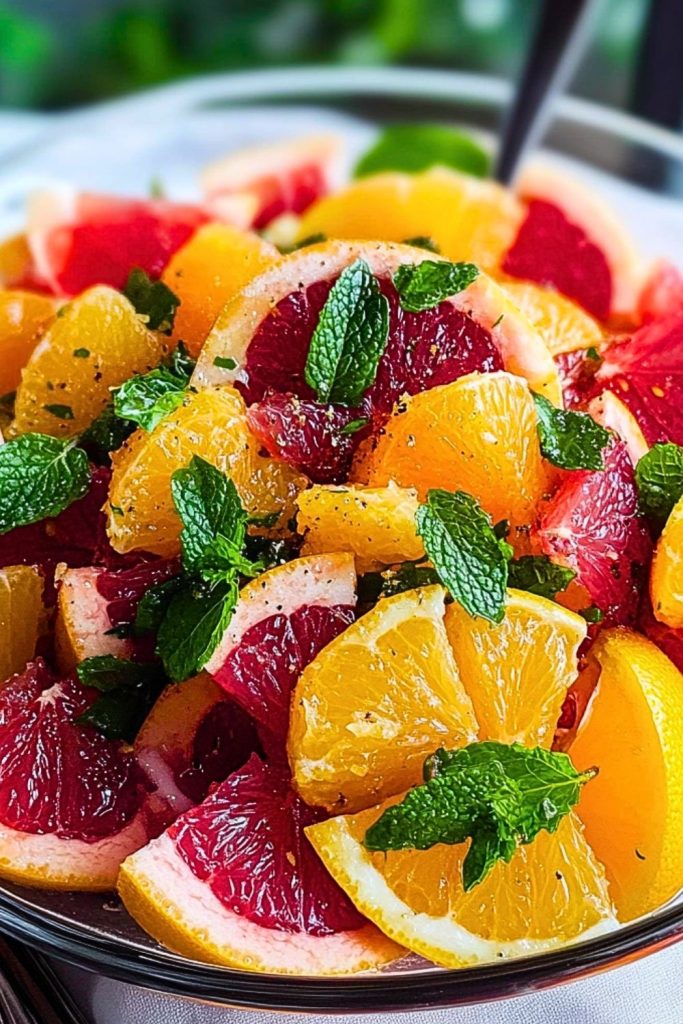Whenever I crave something vibrant, refreshing, and simple yet stunning, I turn to a Citrus Salad. This dish is my go-to winter-to-spring transition plate—it’s like sunshine on a platter. With just a few ingredients, it brings together the sweet tang of citrus, the sparkle of pomegranate seeds, and the freshness of mint. The colors alone are enough to make it the centerpiece of any table, but it’s the flavors that really shine.

What I love most is how this salad plays with contrast. The tartness of grapefruit, the sweetness of oranges, and the bitter edges of blood oranges come alive when paired with juicy pomegranate arils. Finished with mint, it becomes more than just a fruit salad—it’s crisp, cooling, and layered in flavor. Whether it’s for brunch, a holiday side dish, or a healthy dessert, this salad never disappoints.
Why You’ll Love This Citrus Salad
- Naturally sweet and tangy: No need for added sugar, thanks to the fruit’s natural flavor.
- Seasonal and vibrant: Makes the most of winter citrus, bursting with color and antioxidants.
- No cooking required: It’s a raw, fresh salad you can assemble in 10 minutes.
- Elegant but easy: Looks fancy enough for guests, but you barely have to do any prep.
- Healthy: Low in calories, rich in vitamins like C and A, and naturally hydrating.
What Citrus Fruits Work Best for Citrus Salad?
When making a citrus salad, the choice of fruits can really affect the balance of flavors and presentation. I like to use a mix of blood oranges, navel oranges, grapefruit, mandarins, and lemons. Blood oranges add a deep red hue and slight bitterness, while grapefruit brings bold tartness that cuts through the sweetness. Navel oranges and mandarins contribute juicy sweetness, and just a few thin slices of lemon give an aromatic zing that lifts the whole dish.
The trick is to mix and match textures and flavors. You can go entirely sweet if tartness isn’t your thing, or lean into the zesty sharpness if you’re pairing the salad with something savory. Make sure to use firm but ripe fruit so it slices cleanly and holds its shape on the plate.
Options for Substitutions
If you don’t have access to all the citrus types mentioned above, don’t worry—this salad is flexible.
- Instead of blood oranges: Try cara cara oranges or ruby red grapefruit for a similar color and flavor punch.
- Skip the lemon: You can use lime for a sharper twist or omit it for a mellower version.
- No pomegranate? Diced strawberries or red grapes can offer similar bursts of sweetness and color.
- Not a fan of mint? Fresh basil or a few fennel fronds work well and add their own unique notes.
- Want a savory spin? Add avocado slices, a few shaves of fennel, or even some thin red onion for complexity.
Customizing the salad based on what’s in season or on hand is part of what makes it such a joy to prepare. Keep it bright, keep it fresh.
Ingredients
Each ingredient in this salad serves a purpose—bringing color, contrast, and layers of refreshing flavor. Here’s what you’ll need and why it matters:
- Blood Oranges
Their deep crimson flesh adds striking visual contrast and a slightly bitter-sweet edge that balances other citrus fruits beautifully. - Navel Oranges
These are sweet, juicy, and easy to peel, making them a reliable base citrus that everyone enjoys. - Mandarins (or Clementines)
Smaller, super sweet, and easy to segment. They add a tender texture and a cheerful orange hue. - Pink or Ruby Grapefruit
Tart and aromatic with a bold kick, grapefruit brings complexity and just the right amount of bitterness. - Lemon Slices (optional)
Used sparingly, they brighten the dish and intensify the citrus aroma. - Pomegranate Arils
These little ruby gems add crunch, sweetness, and a juicy pop that takes the salad from simple to special. - Fresh Mint Leaves
Mint is the secret to freshness here. Just a few scattered leaves make the whole salad feel cool and garden-fresh. - A Drizzle of Honey or Agave (optional)
If your citrus leans more tart than sweet, a light drizzle can balance it without overpowering the fruit. - Pinch of Sea Salt (optional)
It may sound surprising, but a tiny sprinkle makes the fruit taste even sweeter and livelier.

Step-by-Step – How to Make Citrus Salad
Step 1: Prep the Citrus
Start by peeling all your citrus fruits. Use a sharp knife to carefully slice off the top and bottom, then work your way around the fruit to remove the peel and white pith. This keeps the slices clean and tender. Once peeled, cut the fruit into round slices—about 1/4 inch thick—for a beautiful layered effect.
Step 2: Slice and Arrange
Lay the citrus slices on a large serving platter, overlapping them slightly in an alternating color pattern. This isn’t just for looks—layering also allows the juices to mingle gently on the plate.
Step 3: Add Pomegranate Arils
Scatter a generous handful (or two) of pomegranate seeds across the top of the citrus. They’ll tumble into the gaps and add crunch and jewel-like beauty.
Step 4: Add Mint
Tear a few fresh mint leaves by hand and sprinkle over the fruit. This releases their oils and gives the salad that cool lift it’s known for.
Step 5: (Optional) Drizzle and Season
If your citrus is especially tart, lightly drizzle some honey or agave over the top. A tiny pinch of flaky sea salt can also enhance the natural sweetness of the fruit—don’t skip it if you’re into bold flavor!
Step 6: Chill or Serve Fresh
You can serve the salad immediately or chill it for up to an hour before serving. Just be sure to add the mint last if you’re making it ahead, so it stays crisp and vibrant.
How Long to Make the Citrus Salad
This recipe is a no-cook dish, which means it comes together quickly with minimal effort. You’re mostly slicing, layering, and garnishing—no stove or oven involved.
- Prep Time: 10–15 minutes (depending on how many fruits you use and your knife skills)
- Chill Time (optional): 30 minutes for a colder, juicier result
- Total Time: 15 minutes active, 45 minutes if you choose to chill
If you’re making it for guests, I recommend prepping the citrus and pomegranate a few hours ahead and assembling just before serving to keep everything vibrant.
Tips for Perfect Citrus Salad
- Use a Sharp Knife: This makes slicing the citrus clean and helps avoid crushing the flesh.
- Supreme if You Prefer: For a fancier presentation, segment the citrus (removing the membranes). It’s a bit more effort but creates an ultra-delicate texture.
- Room Temp for Juicier Fruit: Let citrus sit at room temperature for 20 minutes before slicing if it’s been in the fridge. It’ll be juicier and easier to cut.
- Chill the Serving Plate: A cold plate keeps everything crisp and refreshing, especially if serving on a warm day.
- Balance Flavors: Adjust with a touch of honey or salt to hit the sweet/sour mark just right.
- Fresh Mint Only: Dried won’t give you the cooling bite—stick with fresh leaves, gently torn.
Watch Out for These Mistakes While Cooking
Even with a simple dish like citrus salad, a few small missteps can dull the vibrant results. Keep these in mind for the best outcome:
- Using overripe or underripe citrus: Too soft and you’ll end up with mushy slices; too firm and you’ll miss out on juiciness. Pick citrus that feels heavy for its size—juicy and just slightly tender.
- Leaving on the pith: The white part under the peel is bitter. Take the extra minute to fully trim it for clean slices and better flavor.
- Skipping the contrast: Using only one type of citrus makes the flavor fall flat. Mix varieties to get layers of tart, sweet, and slightly bitter.
- Adding mint too early: It wilts quickly. Only toss it on right before serving to keep it fresh and green.
- Letting it sit too long: After about a day, the fruit can start to dry out or become overly soft. Serve the same day for the best texture.
What to Serve With Citrus Salad?
This salad is light, refreshing, and surprisingly versatile. Whether for brunch, lunch, or dinner, here are some great pairing ideas:
Grilled Salmon or Trout
The richness of the fish is balanced beautifully by the citrus acidity. It’s a match made for summer nights or dinner parties.
Roast Chicken
A warm roast and a chilled citrus salad offer a satisfying contrast in both flavor and temperature.
Goat Cheese Crostini
The tangy cheese complements the sweet-tart fruit, and the crunchy bread adds texture.
Quinoa or Couscous
Make it a fuller meal by serving it alongside a grain salad—especially one with nuts or herbs.
Greek Yogurt with Honey
Turn the salad into a brunch centerpiece or even a healthy dessert with a dollop of thick yogurt.
Avocado Toast
The creamy toast paired with sharp citrus is breakfast perfection. Add some chili flakes for heat.
Seared Scallops
Their sweetness works wonders with citrus. This combo feels restaurant-level elegant.
Sparkling Wine or Citrus Spritz
A light drink with bubbles and citrus notes mirrors the salad’s brightness and adds to the refreshment.
Storage Instructions
Citrus salad is best enjoyed fresh, but if you do have leftovers, you can store them with a bit of care:
- Refrigerate in an airtight container: Store the salad in a sealed container to prevent it from drying out and absorbing other fridge odors.
- Best within 24 hours: After that, the fruit starts to break down and release too much juice, which dulls the texture.
- Keep mint separate if possible: If you know you’ll have leftovers, don’t add the mint until just before serving—it wilts quickly in the fridge.
- No freezing: Citrus does not freeze well due to its high water content. It becomes mushy when thawed.
If your citrus salad gets a bit too juicy after chilling, drain the extra liquid or use it as a zesty addition to dressings or marinades.
Estimated Nutrition
The values below are based on a single serving of citrus salad (about 1 cup), using a mix of oranges, grapefruit, pomegranate, and a few mint leaves.
- Calories: 90–110 kcal
- Carbohydrates: 22g
- Sugars: 18g (all naturally occurring)
- Protein: 1–2g
- Fat: 0–1g
- Fiber: 3–4g
- Vitamin C: Over 100% of your daily value
- Other Vitamins: Good source of Vitamin A, potassium, and antioxidants
It’s a naturally hydrating, low-calorie, nutrient-packed option—perfect for any meal or snack.
Frequently Asked Questions
Can I make citrus salad ahead of time?
Yes, you can prep the citrus and pomegranate up to a day in advance, but for best results, assemble the salad and add mint just before serving to preserve texture and freshness.
What’s the best way to cut citrus for salad?
Use a sharp knife to remove the peel and white pith, then slice into rounds or segments. For an elegant presentation, you can supreme the fruit (cutting between the membranes) to get clean, skinless wedges.
Do I need to use all the citrus types listed?
Not at all. Even just two varieties can work beautifully. The key is to balance sweet and tart flavors—mixing something like navel orange with grapefruit or blood orange is a great start.
Is there a dressing required?
No formal dressing is needed—the fruit is juicy enough on its own. But if you’d like, a drizzle of honey, olive oil, or even a citrus vinaigrette can enhance it further.
Can I add greens like arugula or spinach?
Absolutely. Adding peppery greens turns this into more of a citrus salad-meets-green salad hybrid. Just toss lightly and serve immediately so the greens don’t wilt under the fruit’s moisture.
How can I keep the salad from getting too watery?
After slicing, you can pat the citrus rounds lightly with a paper towel before arranging them. Also, avoid stacking too deep—lay the slices in a shallow single or double layer.
What if I want to make this more filling?
You can add avocado, a handful of toasted nuts, crumbled feta or goat cheese, or even grains like farro or quinoa to bulk it up into a light lunch.
Is this salad good for kids?
Yes! It’s colorful, sweet, and full of fruit. Just consider using sweeter citrus like mandarins and oranges over grapefruit if your kids are sensitive to tartness.
Conclusion
Citrus salad is a celebration of freshness—bursting with color, flavor, and health benefits. Whether you’re serving it at brunch, bringing it to a potluck, or enjoying it as a light meal on a sunny afternoon, this salad offers beauty and brightness in every bite. It’s one of those dishes that feels effortless but makes a lasting impression. Keep it seasonal, keep it colorful, and let the fruit speak for itself.

Citrus Salad
- Prep Time: 15 minutes
- Total Time: 15 minutes
- Yield: 4 servings
Description
A vibrant, no-cook salad that combines a medley of sweet, tart, and bitter citrus fruits with fresh mint and juicy pomegranate arils. This Citrus Salad is refreshing, colorful, and loaded with nutrients—perfect for brunches, light lunches, or as a stunning side dish.
Ingredients
- 2 blood oranges
- 2 navel oranges
- 2 mandarins or clementines
- 1 ruby or pink grapefruit
- ½ lemon (optional, thinly sliced)
- ½ cup pomegranate arils
- Fresh mint leaves, for garnish
- 1–2 tsp honey or agave (optional)
- Pinch of flaky sea salt (optional)
Instructions
- Peel all citrus fruits using a sharp knife, removing both the outer peel and white pith.
- Slice the citrus into 1/4-inch thick rounds.
- Arrange the slices on a large serving plate, overlapping for a layered look.
- Sprinkle pomegranate arils evenly over the citrus.
- Tear mint leaves by hand and scatter them over the salad.
- (Optional) Drizzle lightly with honey or agave if desired, and finish with a small pinch of sea salt.
- Serve immediately or chill for up to an hour before serving. Add mint just before serving if made in advance.

